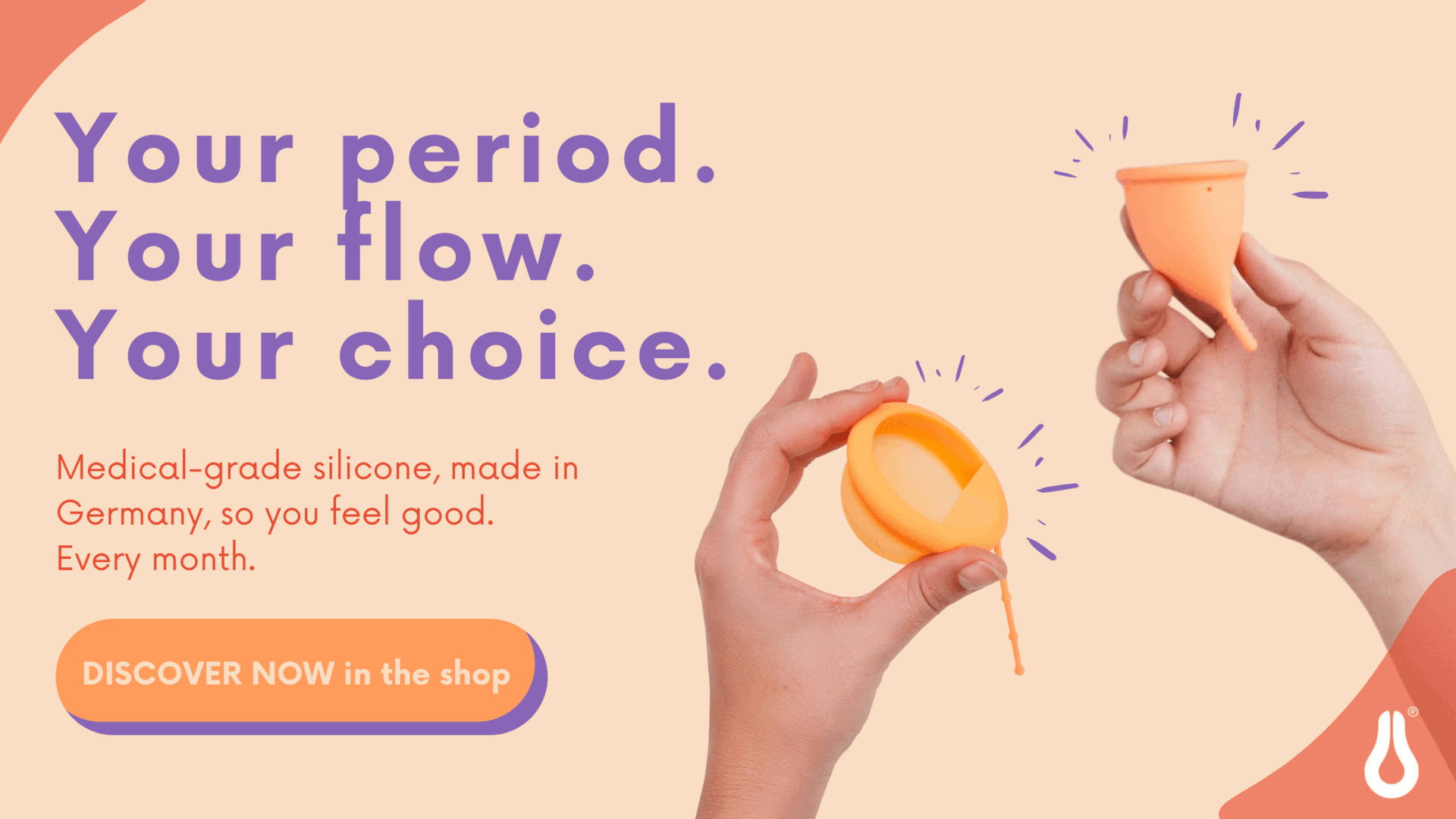
Intimate Care for Women: How to Keep Your Vulva Healthy
15 de November de 2025
Iron deficiency from your period is a common problem. Learn here how to recognize it and counteract it with simple tips!
Inhaltsverzeichnis
- Symptoms of Iron Deficiency – When Should You Pay Attention?
- Stages of Iron Deficiency: How a Deficiency Develops in Your Body
- Causes of Iron Deficiency: Why It Affects Women More
- The Right Nutrition for Iron Deficiency from Your Period
- Iron-Rich Foods & Content (mg per 100 g)
- How Your Body Absorbs Iron and What Prevents It
- Recipes for Iron Deficiency
- Tips Against Fatigue & Lack of Energy
- PapayaCup & PapayaDisc – Help for Heavy Periods
- FAQ: Common Questions About Iron Deficiency from Periods
Iron deficiency is one of the most common nutritional deficiencies in women, and for good reason. Especially during our periods, we lose iron through monthly bleeding. When the loss is significant and the body doesn't replenish the iron quickly enough, a real deficiency can occur. This becomes noticeable through fatigue, concentration problems, and other symptoms.
In this article, you will learn how to recognize iron deficiency from your period, what you can do about it, and which iron sources can help you quickly correct the deficiency. With specific recipes and tips for more energy!
Symptoms of Iron Deficiency – When Should You Pay Attention?
Iron deficiency often develops gradually, especially during your period. Typical symptoms include:
- Persistent fatigue despite enough sleep
- Pale skin or pale mucous membranes
- Concentration problems & headaches
- Frequently feeling cold, cold hands/feet
- Heart palpitations or shortness of breath with minimal exertion
- Brittle nails and hair loss
- Heavy or prolonged menstrual bleeding
- Cracked corners of the mouth, pale gums
If you notice several of these symptoms, it is advisable to get a blood test (ferritin + hemoglobin) with a doctor to rule out or confirm iron deficiency.
If you want to learn more about natural methods to improve your health, also read our article on Hormonal Balance and Cycle-Synced Nutrition

Stages of Iron Deficiency: How a Deficiency Develops in Your Body
To better understand how iron deficiency develops, it's worth taking a quick look at the different stages. They help you assess how far the deficiency has already progressed.
Stage 1: Early Stage (Storage Iron Depleted)
Your ferritin level is low, but your hemoglobin level (Hb) is still normal. You may already feel tired or exhausted.
Stage 2: Impaired Erythropoiesis (Iron Deficiency Without Anemia)
At this point, your body can no longer provide enough iron for new red blood cells. Symptoms like shortness of breath or heart palpitations occur more frequently.
Stage 3: Iron Deficiency Anemia (Anemia)
The Hb level drops. Fatigue, weakness, circulation problems and concentration difficulties are particularly pronounced.
Note: A blood test (ferritin + Hb) quickly shows which stage you are in.
Causes of Iron Deficiency: Why It Affects Women More
The most common cause of iron deficiency in women is monthly menstrual bleeding. Especially with heavy menstrual bleeding, a lot of iron is lost, which can lead to deficiency. Other risk factors include an unbalanced diet, intense physical strain or pregnancy. Women of childbearing age also have a higher risk due to monthly losses.
The Right Nutrition for Iron Deficiency from Your Period
Iron is an essential mineral that the body needs to transport oxygen. There are two different types of iron: Heme iron (from animal products) and Non-heme iron (from plant foods). The body can absorb heme iron much better, but it's also possible to compensate for deficiency with plant-based iron sources – with a few small tricks.
Checklist: Do I Have Iron Deficiency?
You should take these symptoms seriously – especially in combination:
Observation | Possible Indication of Iron Deficiency |
Persistent fatigue despite enough sleep | ✔️ |
Pale skin or pale mucous membranes | ✔️ |
Concentration problems & headaches | ✔️ |
Frequently feeling cold, cold hands/feet | ✔️ |
Heart palpitations or shortness of breath with light exertion | ✔️ |
Brittle nails, hair loss | ✔️ |
Heavy or prolonged menstrual bleeding | ✔️ |
Cracked corners of mouth, pale gums | ✔️ |
If you notice several of these points in yourself, talk to your doctor about a blood test (ferritin + hemoglobin).
Iron-Rich Foods & Content (mg per 100 g)
We've compiled an overview of the best iron-rich foods to help you balance your iron levels during your period:
Food | Iron (mg/100 g) | Category | Tip for Better Absorption |
Pork liver | 18.0 | Animal | Serve with vitamin C-rich salad |
Blood sausage | 30.0 | Animal | Consume only occasionally |
Wheat bran | 16.0 | Plant | In muesli with fruit |
Pumpkin seeds | 8.2 | Plant | Ideal as topping |
Amaranth (uncooked) | 9.0 | Plant | As porridge with berries |
Quinoa (uncooked) | 8.0 | Plant | Combine with bell pepper/orange |
Millet flakes | 6.9 | Plant | In porridge with kiwi |
Lentils (cooked) | 2.5 | Plant | Season with lemon juice |
Spinach (raw) | 2.7 | Plant | With orange dressing |
Cashew nuts | 5.9 | Plant | As snack with apple slices |
How Your Body Absorbs Iron and What Prevents It
Not all iron is absorbed equally well. The body distinguishes between:
- Heme iron (animal): highly available
- Non-heme iron (plant): needs support, e.g. through vitamin C
For your body to optimally absorb iron, you should know the following:
What Improves Iron Absorption:
- Vitamin C (lemon, orange, kiwi, bell pepper, berries)
- Acidic environment (e.g. lemon juice on spinach or lentils)
What Inhibits Iron Absorption:
- Coffee & black tea with meals
- Dairy products (calcium blocks iron)
- Phytates (e.g. in bran, legumes – soak well!)
- Oxalates (e.g. lots of spinach → always combine with vitamin C)
Tip: Always eat plant-based iron together with vitamin C – this way you absorb up to four times more iron.
How to Improve Iron Absorption with Vitamin C
Wondering how you can better absorb iron from plant sources? In this YouTube video you'll learn how to maximize your nutrient absorption with the right combination of iron and vitamin C. Watch it and learn how to optimally use iron from plant foods.
Recipes for Iron Deficiency
Here are some delicious recipe ideas that will help you strengthen your iron levels naturally:
Beetroot Iron Smoothie
Ingredients:
- 1 small cooked beetroot
- 1 orange (peeled)
- 1 kiwi (peeled)
- 1 handful of baby spinach
- Juice of ½ lemon
Preparation: Put all ingredients in the blender, mix well and enjoy!
Tip: Vitamin C from the orange and kiwi promotes iron absorption from the beetroot and spinach.
Iron Bowl with Lentils, Spinach & Millet
Ingredients:
- 50 g millet
- 50 g red lentils (cooked)
- 1 handful of baby spinach
- 2 tbsp pumpkin seeds
- ½ avocado (in pieces)
- Juice of ½ lemon
- Olive oil, salt, pepper
Preparation: Cook millet and lentils, put everything together in a bowl, season with lemon juice, oil and spices.
Tip: The iron from millet and lentils is better absorbed thanks to the vitamin C from the lemon.
Tips Against Fatigue & Lack of Energy
Fatigue is one of the most common symptoms of iron deficiency. We've listed some tips here to quickly recharge your energy:
- Sufficient sleep: Give your body enough rest to regenerate.
- Exercise: A bit of fresh air and light movement like walks or yoga boost circulation.
- Iron-rich diet: Pay special attention during your period to iron-rich foods and avoid foods that inhibit iron absorption.
- Water and herbal tea: Drinking helps the body utilize nutrients better and eliminate toxins. (Our Hormonal Balance Herbal Tea not only helps with hormonal fluctuations but also supports iron absorption – try it during your period!)
PapayaCup & PapayaDisc – Help for Heavy Periods
The menstrual cup from PapayaCup and the PapayaDisc, also called menstrual disc, are ideal companions to control blood loss during heavy periods while stabilizing your iron levels. Both products offer up to 12 hours of secure leak protection and can help you feel freer and safer on heavier days. The menstrual disc can even be worn during sexual intercourse, making it particularly practical if you're looking for a sustainable solution.
Learn how to use the PapayaDisc correctly with our step-by-step video guide:
Iron deficiency from your period is a common issue that affects many women, but it's no cause for worry! With the right nutrition tips, knowledge about symptoms and causes, and a few small self-care tricks, you can help your body feel fit again. PapayaCup & PapayaDisc support you in enjoying the days during your period more freely and with fewer worries.
FAQ: Common Questions About Iron Deficiency from Periods
Typical signs include persistent fatigue, difficulty concentrating, pale skin, brittle nails and frequently feeling cold. Many also notice a general "down feeling" or shortness of breath during exertion. If several of these symptoms occur simultaneously, a blood test with a doctor is worthwhile.
Particularly during menstruation, iron deficiency can be noticeable through extreme exhaustion, headaches, pale skin or heart palpitations. Increased menstrual pain or a feeling of "circulatory collapse" are also possible.
According to the German Nutrition Society (DGE), the requirement is about 15 mg of iron per day, and even 30 mg for pregnant women. With proven deficiency, these amounts are often insufficient - then temporarily higher doses through medically supervised supplements are necessary.
In addition to well-coordinated iron supplementation, the following help: sufficient sleep, iron-rich diet with vitamin C boost, exercise in fresh air and regular meals. Tip: Beetroot smoothie + lemon juice = natural energy boost!
- Have the cause medically clarified
- Check blood values (ferritin, hemoglobin)
- Adjust diet & take supplements if necessary
- Review menstrual management (e.g. PapayaDisc for heavy bleeding)
- Take regeneration seriously - give rest & nutrients!




